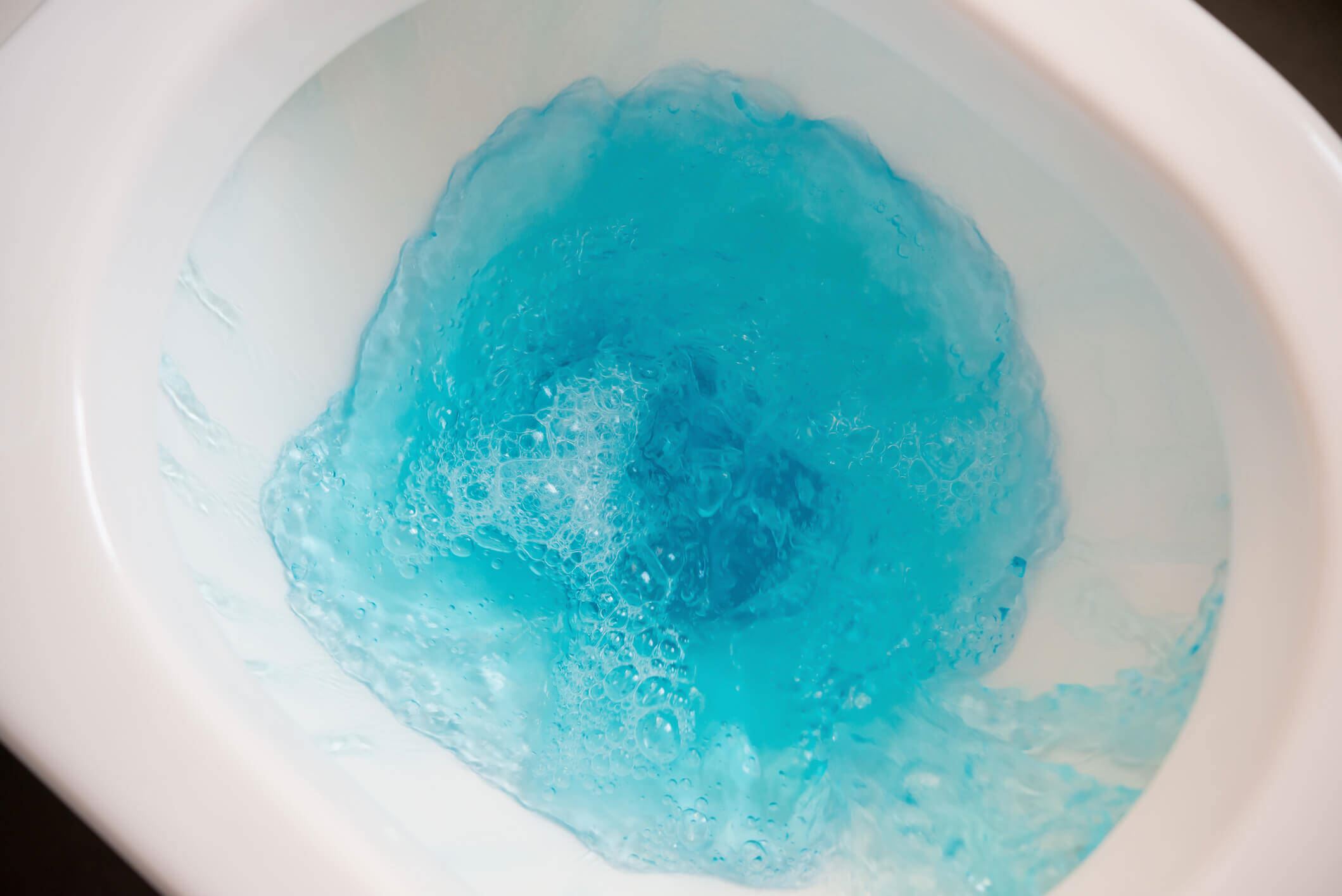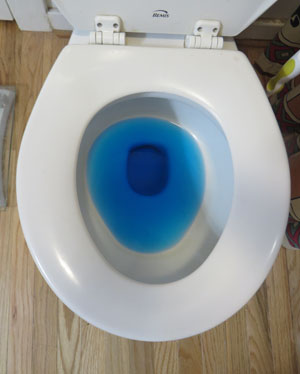Have you ever lifted the lid of your toilet and been taken aback by the sight of blue water? If you’re scratching your head, wondering why your toilet water has suddenly turned into a mini ocean, you’re not alone.
This unexpected splash of color can leave you curious, concerned, or even amused. But before you panic or call a plumber, let’s dive into the reasons behind this colorful surprise. We’ll uncover the mystery of blue toilet water, explore what it means for your plumbing, and discuss whether it’s a cause for concern.
Stick around, and you’ll soon have all the answers you need to put your mind at ease.

Credit: www.pipewrenchplumbing.com
Common Causes Of Blue Toilet Water
Have you ever lifted the lid of your toilet and wondered why the water is blue? This curious phenomenon can be more than a mere aesthetic surprise. There are several common causes that can turn your toilet water an unexpected shade of blue. Understanding these causes can save you from unnecessary worry and guide you in maintaining a healthy plumbing system.
Cleaning Tablets And Chemicals
One frequent culprit of blue toilet water is cleaning tablets. These are often placed in the tank to keep your toilet clean with every flush. While they effectively combat germs, they can also dye the water a striking blue. This is not harmful, but it can be confusing if you’re not expecting it.
Besides tablets, other cleaning chemicals can also cause this color change. If you’ve recently used a cleaner with a blue dye, it may be responsible for the unusual water hue. Always check the labels of cleaning products to understand their effects on your plumbing.
Copper Piping And Mineral Deposits
Does your home have copper plumbing? If so, this might be contributing to the blue water. Copper pipes can leach into the water, especially if they are older or corroded. This can lead to a bluish tint as copper ions dissolve into the water.
Mineral deposits can also play a role. When water with high mineral content flows through your pipes, it can leave deposits that alter the water’s color. If you notice blue water and have copper pipes, it may be time to inspect them for corrosion.
Have you ever thought about the mineral content of your water? It might seem trivial, but understanding this can help prevent plumbing issues. Keep an eye on your pipes and consider regular maintenance to avoid unexpected surprises.
Impact On Plumbing And Fixtures
Discovering blue water in your toilet might feel like an unexpected surprise. While it might initially seem like a harmless change, it’s essential to consider the impact this blue hue can have on your plumbing and fixtures. The color could be a result of cleaning tablets, hard water minerals, or even a reaction with copper pipes. Understanding these implications can save you from potential headaches down the line.
Potential Corrosion Issues
Blue toilet water can indicate the presence of copper in your plumbing system. Copper can react with cleaning chemicals, leading to corrosion. This corrosion might not be immediately visible but could cause long-term damage to pipes.
Corroded pipes can lead to leaks and water pressure issues. Imagine waking up one morning to find a puddle on your bathroom floor. It’s not just a minor inconvenience; it can lead to costly repairs.
Consider using less corrosive cleaning agents or consulting a plumber if you suspect copper corrosion. Regular inspections can help prevent pipe damage before it becomes a severe problem.
Staining And Discoloration
Blue water can stain your toilet bowl and other fixtures. Over time, these stains can become difficult to remove, leaving your bathroom looking less than pristine.
Have you ever scrubbed tirelessly, only to find that stubborn blue ring remains? This is a common frustration for many homeowners. Stains can diminish the appeal of your bathroom and lead to endless cleaning battles.
To prevent this, you might want to switch to cleaning solutions that are less likely to cause discoloration. Regular cleaning can minimize staining, keeping your fixtures sparkling and fresh.
While blue toilet water might seem quirky, it’s crucial to ask yourself if it’s worth potential plumbing issues and unsightly stains. A proactive approach can protect your home’s plumbing system and maintain the beauty of your fixtures.
Health And Safety Considerations
Finding blue water in your toilet might surprise you. This unusual sight can raise questions about health and safety. While it may seem harmless, it’s important to consider the possible risks involved. Let’s explore the potential implications of having blue toilet water.
Chemical Exposure Risks
Blue toilet water is often due to cleaning tablets or agents containing chemicals. These substances can pose health risks if mishandled. Have you ever checked the labels on these products? They often contain harsh ingredients that can irritate skin or eyes.
Accidental ingestion is a serious concern, especially if you have curious pets or young children at home. Always store these products safely and keep the toilet lid closed when not in use. Are you aware of the potential respiratory issues from inhaling fumes? Adequate ventilation can help mitigate this risk.
Environmental Concerns
Beyond personal health, blue toilet water can impact the environment. Have you thought about where the flushed chemicals end up? They usually make their way into water systems, potentially harming aquatic life.
Consider switching to eco-friendly cleaning options. They are designed to minimize environmental damage while maintaining cleanliness. Think about the long-term effects on water quality and biodiversity.
Next time you see blue toilet water, remember there’s more beneath the surface. Consider the health and environmental aspects before choosing cleaning products. Are you ready to make a change for safer home practices?

Credit: www.vin.com
Solutions And Prevention Tips
Finding blue water in your toilet can be a little surprising. It’s not just an aesthetic issue; it can also indicate something about your cleaning habits or the products you use. Luckily, there are simple solutions and prevention tips to ensure your toilet water stays clear and your bathroom remains clean and inviting.
Choosing The Right Cleaning Products
Using the right cleaning products is crucial. Many toilet cleaners contain dyes that can turn your toilet water blue. Check product labels before buying. Opt for clear or natural cleaners to avoid color changes. Consider eco-friendly options which are free from harsh chemicals and dyes.
Why not make your own cleaner? A mix of baking soda and vinegar can effectively clean your toilet without altering the water color. Plus, it’s a cost-effective alternative to store-bought products.
Regular Maintenance Practices
Regular maintenance is key to preventing blue water. Clean your toilet weekly to avoid build-up of residue from cleaning agents. Pay attention to the tank; sometimes the blue dye comes from toilet tablets used there. Replace them with colorless options.
Check for leaks often. A leaking toilet can cause cleaning products to continuously mix with water, altering its color. A simple dye test can help you spot leaks early.
Have you noticed any other changes in your bathroom routine? Adjusting small habits, like the frequency of cleaning or choosing new products, can make a big difference. What’s your go-to solution for keeping your toilet water clear? Share your tips and experiences!
When To Call A Professional
So, you’ve noticed your toilet water is blue, and you’re wondering if it’s time to call in the professionals. While some causes of blue toilet water are harmless, others may require expert intervention. Knowing when to pick up the phone and call a plumber can save you time, money, and a lot of headaches.
Identifying Serious Plumbing Problems
Blue toilet water might be more than just a quirky color change. If you notice leaks or if the blue hue is accompanied by a foul smell, it might be signaling a more serious plumbing issue. Persistent discoloration could be a sign of pipe corrosion, which can lead to larger problems like burst pipes or water damage.
Have you recently used any cleaning tablets that might have caused the blue tint? If not, it could be an indication of mineral buildup in your plumbing system. In such cases, professional assessment is crucial to prevent long-term damage.
Professional Cleaning Services
Sometimes, the culprit of blue toilet water is the cleaning products used. If the color remains after switching products, a professional cleaning service might be needed. They can offer deep cleaning solutions that tackle stains and mineral deposits effectively.
Professional cleaners can also inspect your toilet and plumbing for underlying issues. This ensures that what seems like a simple cosmetic problem doesn’t mask a more significant issue. Are you ready to ensure your toilet is both clean and healthy?
Calling a professional doesn’t always mean bad news—it can be a proactive step. By addressing potential problems early, you can maintain a smoothly running home. So, are you prepared to take action and call in the experts?

Credit: www.reddit.com
Frequently Asked Questions
Why Is My Toilet Water Turning Blue?
Toilet cleaning tablets often cause blue water. They dissolve and release dye.
Is Blue Toilet Water Harmful?
Blue toilet water is usually safe. It may stain surfaces, though. Use gloves when cleaning.
How Can I Remove Blue Stains From My Toilet?
Use vinegar or baking soda. Scrub gently. Rinse well. Repeat if needed.
Can Blue Water Affect Plumbing?
Prolonged use might stain pipes. Regular cleaning helps. Check for persistent issues.
Are There Natural Alternatives To Blue Toilet Cleaner?
Yes, use vinegar, baking soda, or lemon juice. They clean without dyes. Safe and effective.
Conclusion
Blue toilet water might catch your eye. It’s often due to cleaning tablets. These tablets release blue dye. They also clean the toilet bowl. Some people use them for fresh scent. Others like the cleanliness. But remember, regular cleaning is essential.
Tablets don’t replace scrubbing. They help maintain cleanliness. It’s a simple choice. Choose what suits your needs best. Keep your toilet clean and fresh. That’s what matters most. Blue water can be a helpful tool. But it’s not the only solution.
Consider what’s best for your home.




